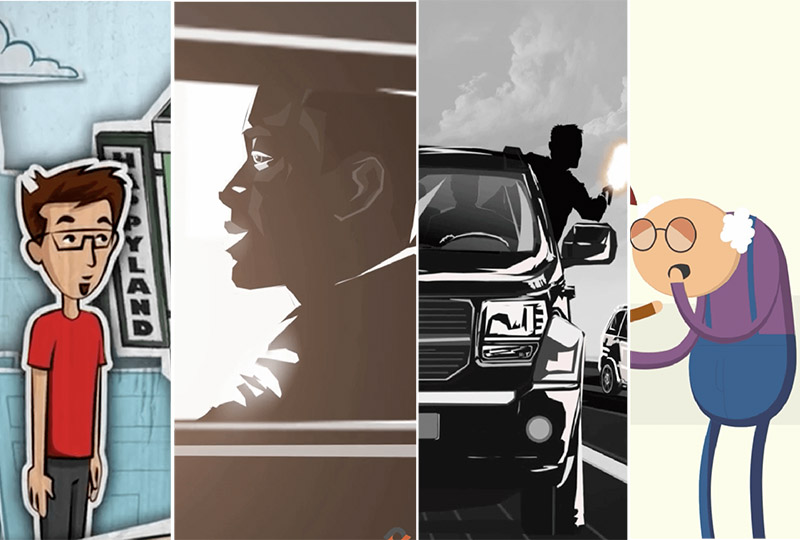Different Styles of Animation Videos
There are many animation styles used today, from the more traditional to the fantastic CGI effects achieved in some of the 3D productions of our time. Animation is the process of rapidly showing a sequence of images that would otherwise be static, to create an illusion of change and motion. Animation can be found in many aspects today including music videos, movies, TV commercials, educational platforms and even in the boardroom. The animation can take the form of 2 dimensional or 3 dimensional characters and figures and be created in a large variety of different styles. Animation can include drawings as well as computer animation of characters and objects. I am going to give a breakdown of the most commonly used animation forms and some of the associated styles, but this is far from an exhaustive list:
Traditional Animation
Classic 2D animation is referred to as the traditional animation style. This type of animation is created by drawing each and every picture by hand, in sequence, changing the following picture slightly from each proceeding one to create the semblance of motion when shown at a certain speed. The hand drawn pictures are transferred onto acetate sheets known as cels, painted by hand and then set against a static painted on background image and photographed individually onto motion picture film using a rostrum camera. Classic movies such as Peter Pan, Sleeping Beauty, The Lion King and Aladdin were done using this technique. This style changed quite dramatically in the 21st century as the hand drawn images are now scanned directly in to the pc or drawn in a program on the computer, software is used to colour the pictures as well as simulate effects and movement. This is then transferred to digital video or the traditional 35mm film. This keeps the look and feel of the ‘old school’ type animation even though some of the work has been done digitally. Some of the styles of traditional animation include : Stick figure animation which consists of simple stick figure drawings (often used in simple explainer videos), Erasure animation (created from charcoal drawings), cartoon and character animation.
Digital 2D Animation
This form of two dimensional animation is created on a computer and uses 2 dimension bitmap graphics and 2 dimensional vector graphics for editing to create animated characters. These animated figures are used in many applications other than just movies, such as your basic GIF files, powerpoint animations and cinematographs to name a few. Fans of Anime will recognize the 2D animation style in hits such as Naruto, Dragonball Z and One Piece. 2D animation was also historically the go-to art form in the video game industry and features in well known games such as The Legend of Zelda and Super Mario Bros. Some of the styles of 2D animation include : Whiteboard animation which is generally black drawings onto white background to look like the standard whiteboard, Motion graphic animation, screen capture which is more the animation of screen captures as opposed to drawings but can use elements of both, animated infographics which are used to educate and often include charts and data, animated music videos and cel-shaded animation to give the illusion of a traditional style animation.
Digital 3D animation
This is generally what people think of when discussing computer animation. Three dimensional animation generally starts with a polygon mesh rendered in 3D which is subsequently manipulated through many vertices to give the illusion of a three dimensional object on screen. Various other processes are applied to give the illusion of water, fur, hair movement and so forth. There are many types of 3D animation styles which include motion capture using live action actors wearing specially designed suits, and the subsequent movements are then used for CGI characters, live action animation which include aspects of live acting and animation and various others. Some of the best known movies containing 3D elements would be Avatar, The Avengers and Transformers. Movies made using 3D animation include Frozen, Big Hero 6, Toy Story and How to train your Dragon series. Games also feature 3D such as the latest Call of Duty, Halo and Bloodborne as examples.
Stop-motion animation
Stop motion is used to animate anything. This is similar to 2D, but the characters do not have to be drawn, they can be physical objects, puppets, figurines or more that are posed and photographed in sequence and then the pictures create a fluid movement when played at the right speed. Some of the styles of stop motion animation include puppet animation using pose-able puppet figures, puppetoons which uses a number of similar puppets in different poses, cut-out animation, silhouette animation, model or object animation using real objects, go motion, brickfilm such as the animation of Lego brick toys, pixilation using posed people, claymation using clay figures, strata-cut animation, Machinima using virtual world screen captures, sand animation using pictures drawn step by step in sand,paint on glass animation, experimental animation and many more.
Kinetic Typography
Kinetic Typography is the animation of letters and number and makes use of various fonts to convey a message or emotion.
Zoetrope Animation
This type of animation is based on a toy called a zoetrope which has images drawn in a circular drum, which when turned in circles gives the illusion of animation.
Drawn on Film animation
This is an old technique, no longer used today which saw the artist etching his drawings straight on to the exposed film or by using light to create specific shadows on the film.
Pinscreen animation
Pin screen was basically created by sticking pins in to a screen in various patterns which create a picture when the screen is lit on one side using light and shadow depending on the depth of the pins.
Flip book animation
Probably the oldest type of animation, this even preceded the traditional animation and consisted of numerous pictures drawn on a flip book or flick book with minor variations per page, so that when the pages are flicked through rapidly, the pictures appear to show motion.
These are just some of the better known animation types, although many of these techniques are no longer used today due to the advent of computer animation.




